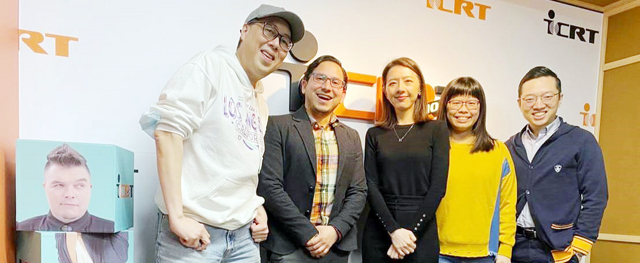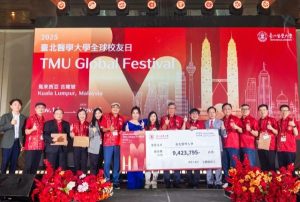牙科不單只是牙齒或口腔,更是了解人體健康的窗口。我的學術研究一直專注於牙周病學,連結、教育、鼓勵和協助一般民眾、學生和同事了解牙科的程序,這是因為沒有正確做到口腔衛生所必需要補強的。基於我的牙周病學背景,在實驗室裡,我們專注研究骨再生的不同生物材料,同時研究如何改善其他異質成形物質及植牙評估,以使牙周失去的組織再生,包括範圍、對功能的期望及美學。
 我在尼加拉瓜國立自治大學取得牙科手術訓練和教育學士學位,透過臺北醫學大學為期兩年的碩士課程,展開了個人的學術訓練和研究經歷,並在北醫大將自己的研究轉換為博士學位。
我在尼加拉瓜國立自治大學取得牙科手術訓練和教育學士學位,透過臺北醫學大學為期兩年的碩士課程,展開了個人的學術訓練和研究經歷,並在北醫大將自己的研究轉換為博士學位。
過去幾年我長期研究項目重點為骨缺損的重建,在牙周病學、顎面外科、移植學和骨科領域,通常可以使用自體骨進行治療。由於其成骨、骨誘導、骨傳導和骨整合特性,自體骨移植被認為是骨再生的黃金標準。然而,當這些缺損龐大又複雜,並且在所需位置要有足夠的骨量時,只使用自體骨是具有挑戰性的,在某些個案可用性有限,自體移植物的取得對病人來說,需要付出某種程度代價,包括額外的手術切口、術後發病率增加、自體組織移植部位弱化和潛在併發症。【左圖:口腔醫學院牙醫學系沙艾思助理教授】
這些不利的影響,使得人們必須找到替代方案,模擬天然骨衍生磷灰石的理化和生物性能,例如異體骨移植、異種骨和合成物或異體骨。新鮮的異體骨移植物之缺點是宿主免疫系統可能產生的排斥反應。此外,相較於直接從動物的硬組織(例如:牛、豬和墨魚骨)製備的生物磷灰石,異種骨不是更複雜,就是成本更高。如今,在多項研究中,豬骨被認為在宏觀結構和微觀結構、化學成分和重塑率方面與人骨最為相似。豬移植物也供應充裕,使其成為重建骨缺損之骨移植材料中絕佳的候選材料。由於我在牙周病學上的背景,個人的主要研究聚焦在豬移植物和其他骨移植材料,包括用於骨再生膜以及如何改善這些生物材料。
 其他研究以植牙和其他問題為中心的骨重建評估,例如其與細菌粘附和纖維母細胞的相互作用。植牙已經發展得很好,成為牙科突破的領域。此一成功帶來牙科的些許問題,例如植體周圍黏膜炎和植體周圍炎,這些疾病已經成為牙醫日常看診預防和治療的主要目標。由於鈦對於骨骼的骨整合能力及其與周圍軟組織的無害關係,已經被認為是用於口腔復健固定裝置和基座的合適材料。【右圖:沙艾思老師(中)進行植牙教學】
其他研究以植牙和其他問題為中心的骨重建評估,例如其與細菌粘附和纖維母細胞的相互作用。植牙已經發展得很好,成為牙科突破的領域。此一成功帶來牙科的些許問題,例如植體周圍黏膜炎和植體周圍炎,這些疾病已經成為牙醫日常看診預防和治療的主要目標。由於鈦對於骨骼的骨整合能力及其與周圍軟組織的無害關係,已經被認為是用於口腔復健固定裝置和基座的合適材料。【右圖:沙艾思老師(中)進行植牙教學】
最近我們專注於開發一種混合纖連蛋白的新型3D膠原支架,其能緩慢重新吸收,具有良好的機械強度和較強的抗撕裂性。研究混合纖連蛋白的新型3D膠原支架的可行性和改善引導組織再生(GTR)治療期間新骨的形成。具有生物可吸收膠原膜(CM)的引導組織再生,通常用於治療牙周缺損。第一型膠原蛋白約佔骨骼全部膠原蛋白含量的95%,約佔骨骼中總蛋白質的80%。纖連蛋白將會用於改善膠原蛋白,因為眾所皆知,透過刺激傷口癒合作為間充質和內層細胞增生的支架,可保留生物活性。(文/沙艾思.口腔醫學院牙醫學系助理教授)【下圖:沙艾思老師(左2)至ICRT廣播電臺介紹北醫大口腔醫學院】

Dentistry is not just teeth or mouth, is the window into human health. All my academic research has always focused on periodontology, to engage, educate, excite, and assist general population, students, and colleagues in understanding dental procedures, that are required after a correct oral hygiene has failed. Consequently, due to my background in periodontology; at our laboratory we have focus on different biomaterials for bone regeneration. Simultaneously how to improve other alloplastic materials and the evaluation of dental implants, which are needed in treatments aimed to regenerate the lost tissues around teeth; including scope of the field, what to expect in function, and aesthetics.
My bachelor’s in dental surgery training and education are from the National Autonomous University of Nicaragua. I started my academic training and research experience by completing a two-years program in Master of science at Taipei Medical University, where I transitioned my research with a PhD.
The long-term research project that has I worked in the last years focuses on Reconstruction of osseous defects, as performed in the fields of periodontics, maxillofacial surgery, implantology and orthopedics, often can be treated with the use of autogenous bone. Autologous bone grafts are considered the gold standard in bone regeneration due to their osteogenic, osteoinduction, osteoconduction, and osseointegration characteristic. However, it is challenging to use only autogenous bone when these defects are large and complex and require adequate bone volume at the desired locations. Availability, which in some cases is shallow, and autograft acquisitions come with a cost for the patient including additional surgical incisions, increased postoperative morbidity, weakened donor bone sites, and potential complications.
These adverse effects make it necessary to discover alternative options that mimic the physicochemical and biological performance of natural bone-derived apatite, such as allografts, alloplastic materials, or xenografts. A disadvantage of fresh bone allografts is the possible rejection by the host immune system. In addition, alloplastic materials are either more complex or costly when compared to biological apatite that is directly prepared from hard tissues of animals (e.g., bovine, porcine, and cuttlefish bone). Nowadays, porcine bone is considered to have the closest resemblance to human bone in multiple studies in terms of macrostructure and microstructure, chemical composition, and remodeling rate. Porcine graft also presents an abundant supply, making it an excellent candidate as bone graft material for reconstructing osseous defects. Consequently, due to my background in periodontology my primary studies have focus on Porcine graft and other bone grafts materials, including membranes for bone regeneration and how to improve these biomaterials.
Other studies have as pivot the evaluation of bone remodeling around dental implants and other problems, like its interaction with bacterial adhesion and fibroblast. Dental implants have been well developed as a breakthrough in dentistry. This success has brought dental problems like peri-implant mucositis and peri-implantitis, diseases that has become part of the dentist’s daily practice main target for prevention and treatment. Titanium (Ti) has been considered the suitable material for fixtures and abutments in oral rehabilitation for its osseointegration in bone capabilities and innocuous relation with surrounding soft tissues.
Recently we have been focusing on the Development of a new 3D collagen scaffold mixed with fibronectin that can reabsorb slowly, have a good mechanical strength and strong resistance against tearing. Research on the new 3D collagen scaffold mixed with fibronectin viability and improvement of new bone formation during Guided tissue regeneration (GTR) treatments. GTR with bioabsorbable collagen membranes (CM)which is commonly used for the treatment of periodontal defects. Type I collagen comprises approximately 95% of the entire collagen content of bone and about 80% of the total proteins present in bone. Fibronectin will be used to improve the collagen because is known to retain biological activities, by stimulating wound healing as a scaffold for the proliferation of mesenchymal and endothelial cells.

